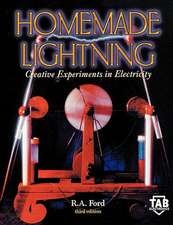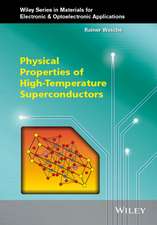Fundamentals of Switching Theory and Logic Design: A Hands on Approach
Autor Jaakko Astola, Radomir S. Stankovicen Limba Engleză Paperback – 19 noi 2010
As is typical to many disciplines a high level of abstraction enables a unified treatment of many methodologies and techniques as well as provides a deep understanding of the subject in general. The drawback is that without a hands-on touch on the details it is difficult to develop an intuitive understanding of the techniques. We try to combine these views by providing hands-on examples on the techniques while binding these to the more general theory that is developed in parallel. For instance, the use of vector spaces and group theory unifies the spectral (Fourier-like) interpretation of polynomial, and graphic (decision diagrams) representations of logic functions, as well as provides new methods for optimization of logic functions.
Consequently, Fundamentals of Switching Theory and Logic Design discusses the fundamentals of switching theory and logic design from a slightly alternative point of view and also presents links between switching theory and related areas of signal processing and system theory. It also covers the core topics recommended in IEEE/ACM curricula for teaching and study in this area. Further, it contains several elective sections discussing topics for further research work in this area
| Toate formatele și edițiile | Preț | Express |
|---|---|---|
| Paperback (1) | 391.61 lei 6-8 săpt. | |
| Springer Us – 19 noi 2010 | 391.61 lei 6-8 săpt. | |
| Hardback (1) | 402.98 lei 6-8 săpt. | |
| Springer Us – 7 mar 2006 | 402.98 lei 6-8 săpt. |
Preț: 391.61 lei
Nou
Puncte Express: 587
Preț estimativ în valută:
74.95€ • 77.96$ • 62.81£
74.95€ • 77.96$ • 62.81£
Carte tipărită la comandă
Livrare economică 13-27 martie
Preluare comenzi: 021 569.72.76
Specificații
ISBN-13: 9781441939456
ISBN-10: 1441939458
Pagini: 356
Ilustrații: XIV, 342 p.
Dimensiuni: 160 x 240 x 19 mm
Greutate: 0.5 kg
Ediția:Softcover reprint of hardcover 1st ed. 2006
Editura: Springer Us
Colecția Springer
Locul publicării:New York, NY, United States
ISBN-10: 1441939458
Pagini: 356
Ilustrații: XIV, 342 p.
Dimensiuni: 160 x 240 x 19 mm
Greutate: 0.5 kg
Ediția:Softcover reprint of hardcover 1st ed. 2006
Editura: Springer Us
Colecția Springer
Locul publicării:New York, NY, United States
Public țintă
Professional/practitionerCuprins
Sets, Relations, Logic, Functions.- Algebraic Structures For Logic Design.- Functional Expressions For Switching Functions.- Decision Diagrams for Representation of Switching Functions.- Classification of Switching Functions.- Synthesis with Multiplexers.- Realizations with ROM.- Realizations with Programmable Logic Arrays.- Universal Cellular Arrays.- Field Programmable Logic Arrays.- Boolean Difference and Applications in Testing Logic Networks.- Sequential Networks.- Realization of Sequential Networks.
Notă biografică
Radomir Stankovic received the B.Sc. degree in electronic engineering from the Faculty of Electronics, University of Ni v, Serbia, Yugoslavia in 1976, and M.Sc. and Ph.D. degrees in applied mathematics from the Faculty of Electrical Engineering, University of Belgrade, Serbia, Yugoslavia, in 1984 and 1986, respectively. Currently, he is a Professor at Department of Computer Science, University of Ni v, Serbia, Yugoslavia. His research interests include spectral techniques, switching theory and multiple-valued logic, and signal processing. He is a member of IEICE.
Jaakko Astola (Fellow IEEE) received B.Sc., M.S.c, Licentiate and Ph.D. degrees in mathematics (specializing in error-correcting codes) from Turku University, Finland, in 1972, 1973, 1975, and 1978 respectively. From 1993 he has been Professor of Signal Processing and Director of Tampere International Center for Signal Processing leading a group of about 60 scientists and was nominated Academy Professor by Academy of Finland (2001-2006). His research interests include signal processing, coding theory, spectral techniques and statistics.
Jaakko Astola (Fellow IEEE) received B.Sc., M.S.c, Licentiate and Ph.D. degrees in mathematics (specializing in error-correcting codes) from Turku University, Finland, in 1972, 1973, 1975, and 1978 respectively. From 1993 he has been Professor of Signal Processing and Director of Tampere International Center for Signal Processing leading a group of about 60 scientists and was nominated Academy Professor by Academy of Finland (2001-2006). His research interests include signal processing, coding theory, spectral techniques and statistics.
Caracteristici
Discusses the fundamentals of switching theory and logic design from a slightly alternative point of view by emphasizing links between switching theory and related areas of signal processing and system theory A good balance between the economy of top-down approach by starting with presenting abstract theory and the benefits of bottom-up approach where explanations are based on examples which are used also to introduce some useful notions and devices Spectral (Fourier-like) interpretation of polynomial, and graphic (decision diagrams) representations of logic functions, and a group-theoretic approach and to optimization problems in switching theory and logic design Vector spaces over various fields are used as the basic algebraic structure for the majority of considerations presented, instead of more classical approaches using Boolean structures












